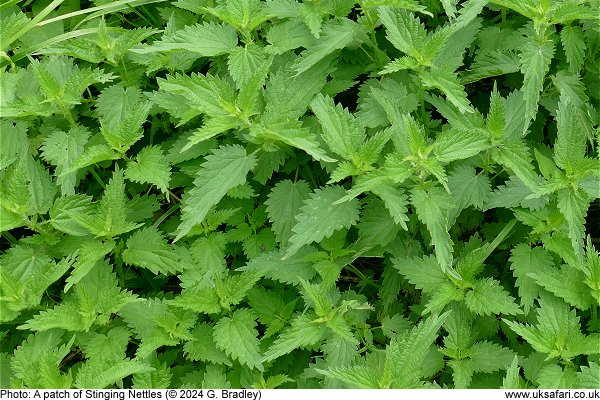 Stinging Nettles
Stinging NettlesIdentify It > Wild Flowers Section > Stinging Nettles >

Scientific name: Urtica dioica
Size: Grows to a height of 150cm
Distribution: Found throughout the UK
Flowering Months: May to September
Habitat: Found in woodlands, woodland edges, parks, gardens, waste ground and road verges
Special features: Stinging Nettles distribute themselves quite rapidly, by seeds, and also by means of their creeping roots, which spread out and then send up new shoots.
The stems and the leaves are covered with tiny, pointed, glass-like stinging hairs. If you touch them, they break off, and penetrate the skin, releasing a complex mixture of chemicals which causes an irritating rash.
The stings are designed as a defense mechanism against browsing cattle and rabbits. Some other plants mimic the appearance of stinging nettles, such as the White Dead Nettle. Although the leaves carry no sting, the look of the leaves is enough to deter most browsing animals.
The Latin name 'dioica' literally means two houses. This is because the male and female flowers are situated on different plants. You can normally tell the sex of a nettle plant by the flowers or the seeds. On a female plant the flowers and seeds hang down, but on a male plant the flowers and seeds stand out.
Although many people dislike them (especially after experiencing a sting), nettles do provide food and shelter for a large number of insects, including the caterpillars of peacock, comma and tortoiseshell butterflies.
 Related Pages
Related Pages

 Popular Pages
Popular PagesAmphibians, Bats, Badgers, Beetles, Birds, Birds of Prey, Bumble Bees, Butterflies, Caterpillars, Climate Change, Deadly Spiders, False Widow Spiders, Frogs, Funny, Garden Spiders, Glow-Worms, Hedgehogs, House Spiders, Owls, Spiders, Toads, What's Out Now?
Copyright © 2024 G. Bradley UK Safari. All rights reserved | About Us | Links | Advertise | Contributors